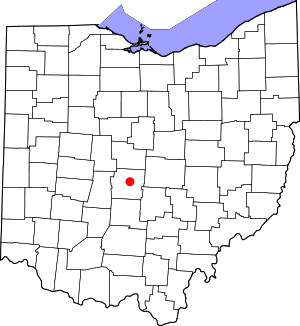Showing posts with label Ohio General Assembly. Show all posts
Showing posts with label Ohio General Assembly. Show all posts
 Image via Wikipedia
Image via WikipediaNow is the Time to Change the Way Ohio
Draws Legislative Districts
This coming year, two events will take place that will help shape the face of Ohio’s political landscape for the next decade – the 2010 census and the statewide elections this November. This is important because the results of the census will determine the number of seats Ohio will have in Congress. The number of people in each Ohio Senate and Ohio House district is also based on an equal distribution of the state’s population.
In addition, the winners of the elections for governor, auditor of state and secretary of state determine the members of the Apportionment Board, which is responsible for creating the maps of Ohio’s legislative districts every 10 years based on the results of the federal decennial census. This process is scheduled to take place next year, and both political parties have a vested interest in the outcome, as the party in power can draw maps that favor its own candidates. This system has been in place for decades and has long been criticized for promoting one-party control of state government and hyper-partisanship, with those in power having more of a say in determining who gets elected than the voters themselves.
Fortunately, it doesn’t have to be this way. The Ohio Legislature is currently considering a proposal that seeks to change the methods used to draw Congressional and legislative districts to make elections more competitive and put the power back in the hands of Ohio voters. Last year, the Senate passed Senate Joint Resolution 5, which was sponsored by Senator Jon Husted (R- Kettering). SJR 5 would replace the Apportionment Board with a seven-member bipartisan redistricting commission responsible for drawing legislative districts.
The redistricting commission would be composed of the governor, auditor of state, secretary of state, the Speaker of the Ohio House, the President of the Ohio Senate, and the minority leaders from each chamber. This is different from the current makeup of the Apportionment Board, which includes only two members of the Ohio General Assembly – one from each party. To approve any new redistricting plan, a five-vote majority is required, with two of the five votes coming from the minority party. This change would ensure that any new plan is created through bipartisan cooperation and that all opinions are heard and taken into consideration.
When drawing Congressional and legislative districts, SJR 5 requires them to be compact and to keep communities together whenever possible. The plan also calls for the commission to try and maximize the number of competitive districts, eliminating the ability of drawing districts that favor one party over another, as has been the case in the past.
To help further increase transparency in the redistricting process, any Ohio resident would be able to submit a Congressional or legislative plan for consideration by the commission. Additionally, once a plan has been adopted by the commission, the members must prepare a public report detailing the methods and reasoning used to create the district maps.
Given the prominent role Ohio plays in our nation’s elections, it is imperative that the system we use to draw legislative districts be fair and balanced instead of one that rewards those in power. Other proposals to reform the redistricting process have been introduced in recent years, and I believe that now is the right time for the Legislature to take on this issue – before the census results are in and before this fall’s elections are complete. Time is of the essence, however, as SJR 5 must be passed before February 3 if it is to be placed on the May ballot for consideration by voters.
SJR 5 is currently under consideration in the House Elections and Ethics Committee, and members of the Ohio House are also working on their own redistricting proposal. I am hopeful that legislators from both chambers will come together in the coming weeks and develop a redistricting plan that is more accountable, less partisan and makes for more competitive elections.
As always, please do not hesitate to contact my office if you have questions or concerns about any state-related matter. You can reach my office by phone at (614) 466-9737, by e-mail at SD07@senate.state.oh.us or by writing State Senator Shannon Jones, Ohio Statehouse, 1 Capitol Square, Columbus, OH 43215. I look forward to hearing from you.
Guest Column From State Representative Peter Beck
Ohio Third Frontier brings jobs and innovation to the state
As the national economy becomes increasingly competitive, it is important that Ohio keeps up in the race for jobs and entrepreneurs. As a caucus, the House Republicans spent the first half of the 128th General Assembly working to retain college graduates, create jobs and improve Ohio’s tax environment to encourage business growth.
In addition to seeking new ways to invigorate the economy, a time-tested initiative continues to be a valuable contributor to our state economy. The Ohio Third Frontier program is a bipartisan initiative that was originally established by Governor Taft in 2002 with the goal of expanding Ohio’s research capabilities and retaining high-wage jobs for future generations. The state’s largest technological investment to date, this $1.6 billion, 10-year commitment to the economy aims to expand Ohio’s high-tech industries while promoting specialized development within the state. Specifically, it builds superior research programs and innovation in key areas, including alternative energy and biomedicine.
By making the Buckeye State an attractive site for tech-based companies and business growth, Third Frontier has created $6.6 billion in economic impact and more than 41,000 jobs for Ohio in just seven years. In fact, in 2006, 2007 and 2008, Site Selection magazine awarded Ohio the Governor’s Cup award for the most facility locations and expansions, with 503 new projects in 2008 alone.
Considering the extreme partisanship that has crippled this General Assembly, the renewal of Third Frontier was a bipartisan collaboration that had not been previously seen in the Statehouse. I’m pleased that Governor Strickland renewed this Republican-championed initiative even during this economically challenging time. Although the Legislature needs to remain cautious of spending projects when faced with significant budget deficits, it is also important to strike a balance by encouraging high-tech businesses while also being mindful of how these investments will affect the taxpayers.
As the Ohio Legislature works to maintain our historically prominent manufacturing and agricultural industries, we will continue to create a statewide competitive advantage that will attract research opportunities and jumpstart our economic recovery. Creating and retaining jobs for Ohioans is my top priority in the Statehouse, and I will continue to fight for pro-growth policies that will improve our state competitiveness and put Ohio back on the map.
I encourage you to contact my office with any questions or concerns. You may reach me by phone at (614) 644-6027 or in writing to State Representative Peter Beck, 77 South High Street, 10th floor, Columbus, OH 43215. I am also available via e-mail at district67@ohr.state.oh.us.
Now is the Time to Change the Way Ohio
Draws Legislative Districts
This coming year, two events will take place that will help shape the face of Ohio’s political landscape for the next decade – the 2010 census and the statewide elections this November. This is important because the results of the census will determine the number of seats Ohio will have in Congress. The number of people in each Ohio Senate and Ohio House district is also based on an equal distribution of the state’s population.
In addition, the winners of the elections for governor, auditor of state and secretary of state determine the members of the Apportionment Board, which is responsible for creating the maps of Ohio’s legislative districts every 10 years based on the results of the federal decennial census. This process is scheduled to take place next year, and both political parties have a vested interest in the outcome, as the party in power can draw maps that favor its own candidates. This system has been in place for decades and has long been criticized for promoting one-party control of state government and hyper-partisanship, with those in power having more of a say in determining who gets elected than the voters themselves.
Fortunately, it doesn’t have to be this way. The Ohio Legislature is currently considering a proposal that seeks to change the methods used to draw Congressional and legislative districts to make elections more competitive and put the power back in the hands of Ohio voters. Last year, the Senate passed Senate Joint Resolution 5, which was sponsored by Senator Jon Husted (R- Kettering). SJR 5 would replace the Apportionment Board with a seven-member bipartisan redistricting commission responsible for drawing legislative districts.
The redistricting commission would be composed of the governor, auditor of state, secretary of state, the Speaker of the Ohio House, the President of the Ohio Senate, and the minority leaders from each chamber. This is different from the current makeup of the Apportionment Board, which includes only two members of the Ohio General Assembly – one from each party. To approve any new redistricting plan, a five-vote majority is required, with two of the five votes coming from the minority party. This change would ensure that any new plan is created through bipartisan cooperation and that all opinions are heard and taken into consideration.
When drawing Congressional and legislative districts, SJR 5 requires them to be compact and to keep communities together whenever possible. The plan also calls for the commission to try and maximize the number of competitive districts, eliminating the ability of drawing districts that favor one party over another, as has been the case in the past.
To help further increase transparency in the redistricting process, any Ohio resident would be able to submit a Congressional or legislative plan for consideration by the commission. Additionally, once a plan has been adopted by the commission, the members must prepare a public report detailing the methods and reasoning used to create the district maps.
Given the prominent role Ohio plays in our nation’s elections, it is imperative that the system we use to draw legislative districts be fair and balanced instead of one that rewards those in power. Other proposals to reform the redistricting process have been introduced in recent years, and I believe that now is the right time for the Legislature to take on this issue – before the census results are in and before this fall’s elections are complete. Time is of the essence, however, as SJR 5 must be passed before February 3 if it is to be placed on the May ballot for consideration by voters.
SJR 5 is currently under consideration in the House Elections and Ethics Committee, and members of the Ohio House are also working on their own redistricting proposal. I am hopeful that legislators from both chambers will come together in the coming weeks and develop a redistricting plan that is more accountable, less partisan and makes for more competitive elections.
As always, please do not hesitate to contact my office if you have questions or concerns about any state-related matter. You can reach my office by phone at (614) 466-9737, by e-mail at SD07@senate.state.oh.us or by writing State Senator Shannon Jones, Ohio Statehouse, 1 Capitol Square, Columbus, OH 43215. I look forward to hearing from you.
November is National Adoption Month
Each year, thousands of children across the United States and here in Ohio are waiting to find a good home with a loving family willing to provide them with the support and care they so desperately deserve. To help promote awareness of the need for adoptive families, November has been designated as National Adoption Awareness Month.
Throughout this month, activities will be held in communities around the state that seek to encourage and connect potential adoptive and foster parents with waiting children. Here in the Ohio General Assembly, my colleagues and I also recognize the need to increase the number of adoptions in our state, which currently stands at roughly 1,900 each year. To that end, we have passed several bills designed to make the adoption process easier and more affordable for families.
Last year, we approved House Bill 7, which encourages adoption agencies to approach adoption with a focus on the best interests of the child, including considering family members and friends when recruiting potential adoptive parents. The bill also reduces duplicative paperwork and training, and will allow families participating in a private adoption to pay the birth mother’s living expenses during the pregnancy and up to two months after the birth.
Whether a family uses a public or private agency to complete an adoption, the costs can be substantial. Some adoptions may only cost a few thousand dollars, while international or private adoptions can cost more than $30,000. I was pleased to be a co-sponsor of a bill that increased the adoption tax credit in Ohio from $500 to $1,500. This credit is in addition to any federal adoption tax credits the family may be eligible to receive and will help encourage more families to consider opening their home to a child in need of their love and support.
Although a great deal of effort has been made in recent years to increase the number of adoptions, we also need to encourage more people to become foster parents. These individuals play a critical role in the lives of children whose parents or guardians are unable to care for them, providing them with the support and care they need until they can be reunited with their families or placed in a permanent home.
Legislators have also worked in recent years to reform our state’s foster care system and ensure foster children are placed in safe and stable homes. That is why the Legislature has passed bills in the last year that provide added protections for children in foster care, improved cooperation among government agencies to prevent children from being placed in dangerous homes and more information to public service agencies, better enabling them to remove a child should problems develop. The legislation also helps ensure agencies are better equipped to identify a child’s specific needs prior to placement and that prospective foster parents have the training they need to meet those needs.
In addition, we have also passed measures that expand the list of offenses that would prevent an individual from becoming a foster or adoptive parent and require potential foster parents to submit to an FBI background check prior to becoming certified and again when they apply for renewal. This will catch any transgressions that occur between the two applications. These changes will help strengthen the training and services available to foster parents while also keeping children safe.
If you would like more information about becoming a foster or adoptive parent, please contact the Ohio Department of Jobs and Family Services by calling 1-866-886-3537 and selecting option 4 or going online to www.jfs.ohio.gov/oapl. You can also contact the Warren County Children’s Services Bureau at by phone (513) 695-1546 or online by visiting www.co.warren.oh.us/
Our children are one of our most precious resources and need good homes with loving parents to nurture and care for them. By promoting the need for adoptive and foster parents and making the adoption process easier for families, we can give more children the opportunity to find a safe and loving permanent home.
As always, please do not hesitate to contact my office if you have questions or concerns about any state-related matter. You can reach my office by phone at (614) 466-9737, by e-mail at SD07@senate.state.oh.us or by writing State Senator Shannon Jones, Ohio Statehouse, 1 Capitol Square, Columbus, OH 43215. I look forward to hearing from you.





![Reblog this post [with Zemanta]](http://img.zemanta.com/reblog_e.png?x-id=9f7db741-31c7-403f-bcfc-52e16fdeddae)

![Reblog this post [with Zemanta]](http://img.zemanta.com/reblog_e.png?x-id=9f3ef380-c739-4b3d-a953-12a8b1054c69)

![Reblog this post [with Zemanta]](http://img.zemanta.com/reblog_e.png?x-id=9834a58f-85f0-4c53-a062-f9d7e319f219)

![Reblog this post [with Zemanta]](http://img.zemanta.com/reblog_e.png?x-id=de40cd0c-f3af-4c48-b799-64412fc9c74b)







